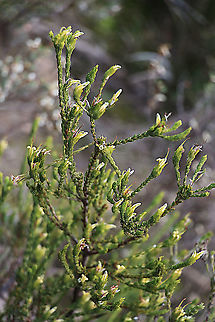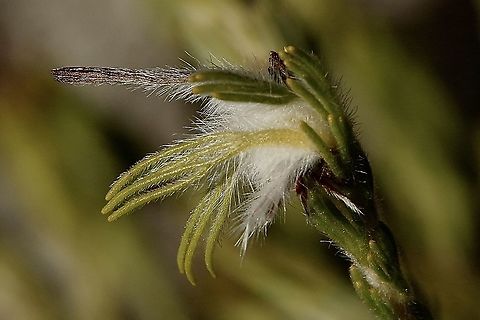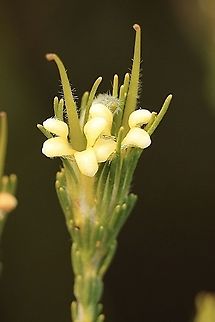
Appearance
''Adenanthos terminalis'' grows as an upright shrub, usually no more than 1 m high, but occasionally up to 2 m. It lacks a lignotuber. Branches are held erect, and are covered in hairs that lie close along the stem. The leaves are laciniate, being segmented by threes into between three and seven, but most often five, long thin laciniae, each between 5 and 15 mm long, and around 0.5 mm in diameter.They most occur clustered at the ends of the branches, but some persist on the stem. Stem leaves are most hairless, and smaller than the leaves that surround the flower, which often have long hairs near their bases.
Unlike most other ''Adenanthos'' species, the inflorescence of ''A. terminalis'' is not always reduced to a single flower: flowers may occur in groups of up to three. They are usually hidden by the surrounding floral leaves, and consist of a perianth up to 16 mm long, and a style up to 30 mm long. The perianth is white to cream in colour, sometimes with some green, and covered in short hairs on the outside. The style is also nearly always hairs, and the ovary is densely haired.

Distribution
The species is found in southern regions of Australia, from the Eyre Peninsula and Kangaroo Island in South Australia, to the Big and Little deserts of Victoria. The eastern limit of the species is at Wyperfeld National Park, making this the more easterly species of ''Adenanthos''. It occurs in deep sandy soils, or sometimes in lateritic soils, amongst mallee scrub.
Habitat
In a 1977 study conducted in South Australia, designed to gather evidence for the premise that honeyeaters pollinate the flowers they visit, ''A. terminalis'' flowers were regularly visited by ''Acanthorhynchus tenuirostris'' , ''Anthochaera chrysoptera'' , ''Phylidonyris pyrrhoptera'' , ''Phylidonyris novaehollandiae'' and ''Gliciphila melanops'' . Pollen of ''A. terminalis'' was recovered from the facial feathers of individuals of all of these species except ''Anthochaera chrysoptera'', and also from ''Melithreptus brevirostris'' .It is susceptible to ''Phytophthora cinnamomi'' dieback.The species is found in southern regions of Australia, from the Eyre Peninsula and Kangaroo Island in South Australia, to the Big and Little deserts of Victoria. The eastern limit of the species is at Wyperfeld National Park, making this the more easterly species of ''Adenanthos''. It occurs in deep sandy soils, or sometimes in lateritic soils, amongst mallee scrub.
References:
Some text fragments are auto parsed from Wikipedia.